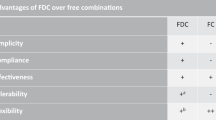Abstract
Current international guidelines recommend the use of therapeutic strategies with proven efficacy in the management of hypertension to achieve a target blood pressure of <140/90 mmHg. After lifestyle intervention, they endorse three different management strategies: (i) first-line use of a low-dose combination of two agents from different antihypertensive classes, with the option of doubling the dose of the combination; (ii) use of a sequential monotherapy strategy, initiating with one antihypertensive to be replaced by another one from a different class, if necessary; and (iii) a stepped care strategy, initiating with one antihypertensive, and increasing the dose or adding another agent from a different class, if necessary. The objective of the STRAtegies of Treatment in Hypertension: Evaluation (STRATHE) study was to compare the efficacy and tolerability of these three treatment strategies in patients with uncomplicated essential hypertension (n=533). In all, 62% of the patients in the low-dose combination group were normalised (<140/90 mmHg), compared with 49% of the sequential monotherapy group (P=0.01) and 47% of the stepped-care group (P=0.005). The percentage of patients achieving normalisation without experiencing drug-related adverse events was also significantly higher in the low-dose combination group (56%) than in the sequential monotherapy (42%, P=0.001) and stepped-care groups (42%, P=0.004), consistent with the observation that the reduced dosage of the antihypertensive agents in such preparations translates into improved acceptability. The results of STRATHE provide further support for an antihypertensive management strategy involving the low-dose combination of perindopril (2 mg) and indapamide (0.625 mg).
This is a preview of subscription content, access via your institution
Access options
Subscribe to this journal
Receive 12 digital issues and online access to articles
$119.00 per year
only $9.92 per issue
Buy this article
- Purchase on Springer Link
- Instant access to full article PDF
Prices may be subject to local taxes which are calculated during checkout


Similar content being viewed by others
References
Guidelines Committee. 2003 European Society of Hypertension European Society of Cardiology guidelines for the management of arterial hypertension. J Hypertens 2003; 21: 1011–1053.
Chobanian AV, et al, the National High Blood Pressure Education Program Coordinating Committee (2003). Seventh Report of the Joint National Committee on Prevention, Detection, Evaluation, and Treatment of High Blood Pressure. Hypertension 2003; 42: 1206–1252.
World Health Organization (2003). 2003 World Health Organization (WHO)/International Society of Hypertension (ISH) statement on management of hypertension. J Hypertens 2003; 21: 1983–1992.
Vivki L et al. Trends in prevalence, awareness, treatment, and control of hypertension in the adult US population. Hypertension 1995; 26: 60–69.
Dusing R, Weisser B, Mengden T, Vetter H . Changes in antihypertensive therapy — the role of adverse effects and compliance. Blood Press 1998; 7: 313–315.
Berlowitz DR et al. Inadequate management of blood pressure in a hypertensive population. N Engl J Med 1998; 339: 1957–1963.
Cushman WC et al. Success and predictors of blood pressure control in diverse North American settings: the antihypertensive and lipid-lowering treatment to prevent heart attack trials (ALLHAT). J Clin Hypertens 2002; 4: 393–404.
Dahlöf B et al. Cardiovascular morbidity and mortality in the Losartan Intervention for Endpoint Reduction in hypertension study (LIFE): a randomised trial against atenonol. Lancet 2002; 359: 995–1003.
Pepine CJ et al. A calcium antagonist vs a non-calcium antagonist hypertension treatment strategy for patients with coronary artery disease. The International Verapamil-Trandolapril Study (INVEST): a randomized controlled trial. JAMA 2003; 290: 2805–2816.
Mourad J, et al, on behalf of the investigators of the STRATHE trial (2004). Comparison of different therapeutic strategies in hypertension: a low-dose combination on perindopril/indapamide versus a sequential monotherapy or a stepped-care approach. J Hypertens 2004; 22: 2379–2386.
Waeber B . Very-low-dose combination: a first-line choice for the treatment of hypertension. J Hypertens 2003; 21(Suppl 3): S3–S10.
Myers MG et al. Fixed low-dose combination therapy in hypertension — a dose response study of perindopril and indapamide. J Hypertens 2000; 18: 317–325.
Laurent S . Very-low-dose combination of perindopril and indapamide: efficacy on blood pressure and target-organ damage. J Hypertens 2003; 21(Suppl 3): S11–S18.
Neutel JM, Smith DHG, Weber MA . Low-dose combination therapy: an important first-line treatment in the management of hypertension. Am J Hypertens 2001; 14: 286–292.
Chanudet W, De Champvallins M . Antihypertensive efficacy and tolerability of low-dose perindopril/indapamide combination compared with losartan in the treatment of essential hypertension. Int J Clin Pract 2001; 55: 233–239.
Asmar RG, London GM, O'Rourke ME, Safar ME, for the REASON Project coordinators and investigators. Improvement in blood pressure, arterial stiffness and wave reflections with a very-low-dose perindopril/indapamide combination in hypertensive patient, a comparison with atenolol. Hypertension 2001; 38: 922–926.
Morgan T, Anderson A . Low-dose combination therapy with perindopril and indapamide compared with irbesartan. Clin Drug Invest 2002; 22: 553–560.
Mogensen CE et al. Effect of low-dose perindopril/indapamide on albuminuria in diabetes, Preterax in Albuminuria Regression: PREMIER. Hypertension 2003; 41: 1063–1071.
Mourad JJ, Balcher J, Blin P, Warzocha U, on behalf of the investigators of the PHASTE study. Conventional antihypertensive drug therapy does not prevent the increase of pulse pressure with age. Hypertension 2001; 38: 958–962.
Chalmers J, Castaigne A, Morgan T, Chastang C . Long-term efficacy of a new, fixed, very-low-dose angiotensin-converting enzyme-inhibitor/diuretic combination as first-line therapy in elderly hypertensive patients. J Hypertens 2000; 18: 327–337.
Author information
Authors and Affiliations
Corresponding author
Rights and permissions
About this article
Cite this article
Zannad, F. Managing hypertension: a question of STRATHE. J Hum Hypertens 19 (Suppl 1), S3–S7 (2005). https://doi.org/10.1038/sj.jhh.1001886
Published:
Issue Date:
DOI: https://doi.org/10.1038/sj.jhh.1001886



